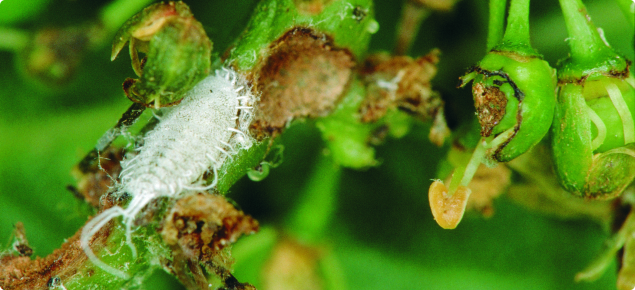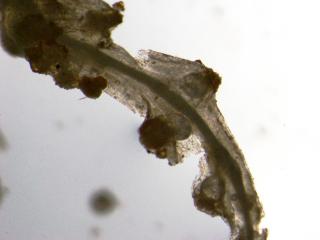Aphids
Aphids are small, 1-3mm, soft-bodied insects that can be green, grey, or black. They are a common pest on everlastings all year round, but are commonly seen in spring and autumn on other plants. Aphids can be winged or wingless and are usually slow-moving.
Aphids cluster on the tips of the shoots, sucking the sap from the plant, which reduces plant vigour. Aphids can also spread viruses which can damage the plant. A number of natural enemies, such as ladybirds and lacewings, will provide biological control if chemical sprays are not used. Soapy water and insecticidal soaps may also reduce numbers or spray with neem, imidacloprid, acetamiprid, garlic extract or pyrethrum.
For more detailed information read aphids, mealybugs and scales.
Borers
Borers are insects, which bore holes into native or exotic plants. A range of insects is involved, mostly beetles and their larvae. They live mainly in living, but generally weakened plants and in bad cases cause death. Groups of borers include beetles, wood moths, weevils and termites.
Longicorn beetles range in size from 15-50mm and are a large group that is commonly seen in summer. They have powerful jaws, and are often confused with the European House Borer, which is a quarantine pest in Western Australia. However, European house borer adults are smaller at 8-25mm and have shorter antennae.
Healthy plants are normally able to tolerate borer attacks, with new growth outgrowing the weakened branches and exudation of gum restricting borer activity. Affected old branches will break off.
Natural enemies of borers are birds, the assassin bug, predacious beetles and parasitic wasps and fungi. Kerosene or soap solution, poured into the tunnels may cause the grub to emerge for destruction.
Caterpillars that build shelters
A number of native plants are affected by caterpillars that construct shelters to protect themselves from predators. These caterpillars may be solitary or gregarious and mostly affect plants in autumn.
They hide in the shelters during the day and emerge to feed during the night. The shelters may vary from joined adjacent leaves or curling leaves to large solid constructions such as bags or mobile homes. Bag shelter moths, bag moths, case moths, bag worms and leaf rollers belong to these groups. In Western Australia web moths are a common pest on thryptomene and melaleuca. The symptoms are browning leaves and leafless branches and signs are webbing around the leaves.
Control the bugs by hand picking, ensuring that the bags are destroyed after removal.
Crusader bugs
Crusader bugs commonly attack wattles and cassias and to a lesser extent eucalyptus, hibiscus and a wide range of exotic plants. They are about 20mm long, most active in summer and cause shoots and flowers to wilt and die.
Crusader bugs have a pale yellow cross on their backs when their wings are folded. When disturbed they spray a stinking fluid.
If possible control the bugs through hand picking. Many predators control crusader bugs, including birds, spiders, assassin bugs and parasitic wasps.
Lerps
Lerps are sap sucking insects which attack the leaves of a variety of native plants, particularly eucalypts. Like scales, the insects are protected with a waxy covering. They attack new shoots and leaves and cause severe distortion, bronzing of leaves and death of tissue. Like other sap-suckers, they produce honeydew, which encourages the growth of sooty mould. Soon after a lerp infestation, leaves turn brown and are shed prematurely.
Lerps are controlled naturally by a variety of predators, including small birds, hunting spiders, scorpions, assassin bugs, ladybirds, lacewings and parasitic wasps.
Chemical control is not practical on big trees but seedlings can be sprayed with a mix of malathion and white oil.
Mealybugs
Mealybugs are small sapsucking insects covered in a white protective wax which are usually found in protected areas.
They are a year round problem on indoor or glass house pot plants as well as outdoor palms and ferns. Occasionally, mealybugs affect other plants such as grevilleas and wattles.
Natural predators such as beetles or parasitic wasps can often keep mealybug numbers under control. It may also be necessary to control ants, which protect the pests from their natural enemies. A soil drench of imidacloprid or acetamiprid is often needed for control as mealybugs also live on the roots of the plants as well as the foliage.
Mites
Adult mites have eight legs compared to insects, which have six legs and are much smaller at less than 1mm. A big range of mites affect native plants with two spotted mite and bryobia mite being the most common.
Foliage affected by mites has yellow stippling and is russetty and dry. Peppermints, the most common being Agonis flexuosa, are often affected.
The undersides of the affected leaves usually have fine webs, under which there are hundreds of small yellow-to-red mites which are 0.5 to 1mm in size and pearly eggs. Predators such as pinhead-size black ladybirds and predatory mites can sometimes keep mite numbers under control. The predatory mites are usually fast-moving and some are bright orange.
Mites like dry conditions and water sprayed beneath the foliage will reduce numbers. If necessary, control with horticultural soap, sulphur or white oil (horticultural oil). Spray at the first sign of pest damage to obtain good control.
Nematodes
Nematodes are microscopic worm-like animals that live in the soil. They cannot be seen with the naked eye.
Nematodes may damage the roots of some native plants, especially sturt peas and eremophilas in sandy soils. Some nematodes affect the stem or the leaves. They are most active in summer. Root knot nematode damage is seen as enlarged swellings on the roots and by wilting of the plants. Nematodes also provide sites for increased disease infection. Increasing the amount of organic matter in the soil and planting marigolds will help reduce nematode numbers. Read web article Nematodes for further information.
Scales
Scale insects are about 2–3mm long and attack a wide range of plants including Western Australian peppermints (Agonis flexuosa) and eucalypts. Scales are sapsuckers and also cause a fungus, known as ‘sooty mould’ which grows on the sugary excretions of the scales. Severe infestations of scale insects can result in defoliation, retard growth, and can result in plant death.
Scale insects have a waxy cover which they use to protect themselves. There are hundreds of species of scale insects in Australia with soft or hard armoured covering.
Scale insects are controlled naturally by ladybirds, assassin bugs, lacewings, hover flies, parasitic wasps, birds and possums. Chemical control is achieved using imidacloprid or acetamiprid and horticultural oil.
Woolly bear caterpillar
Tiger moth or woollybear caterpillars are a common pest on kangaroo paws and everlastings in winter. They affect a wide range of herbaceous plants including vegetables and natives.
When handpicking the larvae wear gloves, as the hairs can cause itchiness. For chemical control use products containing Bacillus thuringiensis, neem oil or spinosad.
Snails, slugs and slaters
These molluscs will attack most plants and chew holes in leaves and kill seedlings.
Amongst WA native plants they are a significant pest on kangaroo paws and everlastings. They are most active at night, especially in moist weather. Control, using baits or traps. Control is especially important in April and May when the adults lay eggs. Read web article Snail and slug control for more detailed information.
If populations of slaters become too numerous they will eat seedlings. Reduce numbers using baits and traps. Read web article Slaters for further information.
Unfamiliar pests
There are occasions when a home gardener may notice a new pest, which is different to the pests they have seen in the past. Exotic pests are a concern as they could pose a threat to agriculture and the environment.
If you discover something unfamiliar please send a photo to the Pest and Disease Information Service (PaDIS) by email: info@agric.wa.gov.au or phone them on Freecall: 1800 084 881.
Please read the sending specimens for identification web article before sending samples to the Pest and Disease Information Service, 3 Baron-Hay Court, South Perth, 6150, WA.











